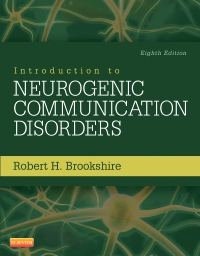
Introduction to Neurogenic Communication Disorders - Elsevier eBook on VitalSource, 8th Edition
Elsevier eBook on VitalSource

Give your students the tools they need to evaluate, diagnose, and treat patients with neurogenic communication disorders! This bestselling text provides a solid foundation in the neurology of communication, as well as the causes, symptoms, diagnosis, assessment, and management of commonly encountered neurologenic communication disorders in adults. A concise, evidence-based approach shows how to measure and treat abnormalities such as aphasia, dysarthria, right-hemisphere syndrome, and traumatic brain injury syndrome. Updated with new coverage of laboratory tests, blast-related injuries to the head, and medications for dementia, this text will help your students develop skills in the rehabilitation of clients with neurogenic communication disorders.
-
- NEW content on closed-head injuries as a consequence of blast injury is included in the Traumatic Brain Injury chapter, addressing a pathophysiology often found in Iraq and Afghanistan war veterans.
- UPDATED content includes new information on medications for treatment of persons with dementia, the latest laboratory tests for neurologic assessment, and the most current cognitive rehabilitation approaches.
- Thought questions in each chapter — NEW questions are included — provide realistic scenarios and challenge students to assess their understanding, think critically, and apply information to clinical situations. Suggested answers are included in the appendix.
- Additional content on evidence-based practice includes systematic reviews and meta-analyses relating to the efficacy and effectiveness of specific treatment approaches.
- Clinical vignettes show how to apply principles to practice and illustrate how patients are evaluated and treated.
- A clear, concise approach makes complex material easy to follow and understand.
- More than 200 photographs and images include anatomic illustrations, scans using various brain imaging techniques, and examples of assessment tests.
- Clinically relevant sidebars include related facts, information, and tips for recall or therapy.
- General Concepts summary points highlight the most important material in each chapter.
- Student-friendly features enhance learning with chapter outlines, critical thinking exercises, medical protocols, sample paperwork, patient transcripts, commonly used medical abbreviations, and a glossary with definitions of key vocabulary.
-
- NEW content on closed-head injuries as a consequence of blast injury is included in the Traumatic Brain Injury chapter, addressing a pathophysiology often found in Iraq and Afghanistan war veterans.
- UPDATED content includes new information on medications for treatment of persons with dementia, the latest laboratory tests for neurologic assessment, and the most current cognitive rehabilitation approaches.
- NEW! More Thought questions in each chapter help you apply concepts to clinical situations.
- Additional content on evidence-based practice includes systematic reviews and meta-analyses relating to the efficacy and effectiveness of specific treatment approaches.
- Additional graphics, clinical photographs, and tables depict key information and concepts.
-
1. Neuroanatomy and Neuropathology
2. Neurologic Assessment
3. Assessing Adults Who Have Neurogenic Cognitive-Communicative Impairments
4. Assessing Cognition
5. Assessing Language
6. Assessing Functional Communication and Quality of Life
7. The Context for Treatment of Cognitive-Communicative Disorders
8. Neuroanatomic Explanations of Aphasia and Related Disorders
9. Treatment of Aphasia and Related Disorders
10. Right Hemisphere Syndrome
11. Traumatic Brain Injury
12. Dementia
13. Motor Speech Disorders
Medical Abbreviations
Answers to Thought Questions
Bibliography

 as described in our
as described in our 